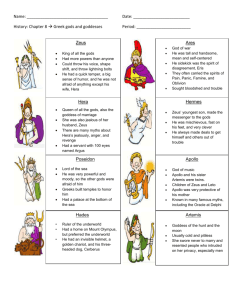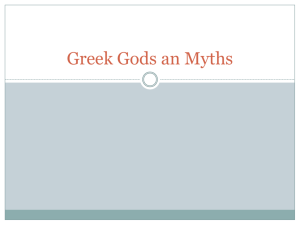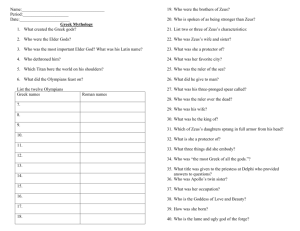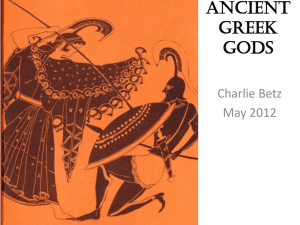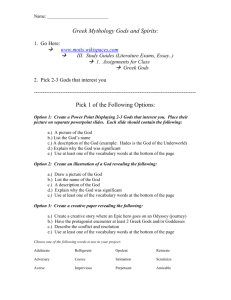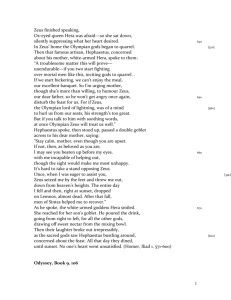Greek gods argumentative essay
advertisement
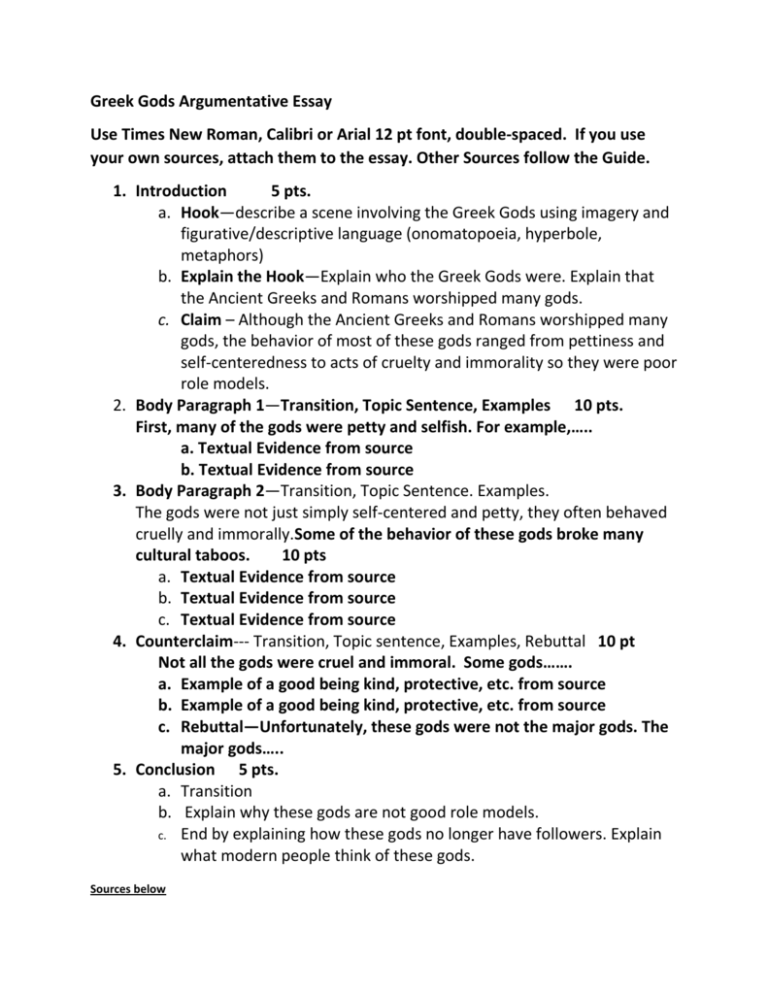
Greek Gods Argumentative Essay Use Times New Roman, Calibri or Arial 12 pt font, double-spaced. If you use your own sources, attach them to the essay. Other Sources follow the Guide. 1. Introduction 5 pts. a. Hook—describe a scene involving the Greek Gods using imagery and figurative/descriptive language (onomatopoeia, hyperbole, metaphors) b. Explain the Hook—Explain who the Greek Gods were. Explain that the Ancient Greeks and Romans worshipped many gods. c. Claim – Although the Ancient Greeks and Romans worshipped many gods, the behavior of most of these gods ranged from pettiness and self-centeredness to acts of cruelty and immorality so they were poor role models. 2. Body Paragraph 1—Transition, Topic Sentence, Examples 10 pts. First, many of the gods were petty and selfish. For example,….. a. Textual Evidence from source b. Textual Evidence from source 3. Body Paragraph 2—Transition, Topic Sentence. Examples. The gods were not just simply self-centered and petty, they often behaved cruelly and immorally.Some of the behavior of these gods broke many cultural taboos. 10 pts a. Textual Evidence from source b. Textual Evidence from source c. Textual Evidence from source 4. Counterclaim--- Transition, Topic sentence, Examples, Rebuttal 10 pt Not all the gods were cruel and immoral. Some gods……. a. Example of a good being kind, protective, etc. from source b. Example of a good being kind, protective, etc. from source c. Rebuttal—Unfortunately, these gods were not the major gods. The major gods….. 5. Conclusion 5 pts. a. Transition b. Explain why these gods are not good role models. c. End by explaining how these gods no longer have followers. Explain what modern people think of these gods. Sources below SOURCE 1 Hera http://www.greekmythology.com/Olympians/Hera/hera.html Hera was Zeus' wife and sister. She was the supreme goddess, patron of marriage and childbirth, having a special interest in protecting married women. Zeus initially courted Hera, but after many unsuccessful attempts, he resorted to trickery. He took the form of a sick bird; Hera, feeling sorry for the bird, held it to her breast to keep it warm. Zeus then resumed his normal form and taking advantage of Hera's surprise, he raped her. Hera then married him to cover her shame; their marriage was turbulent and they often clashed. Occasionally, Zeus treated the other gods with particular harshness; Hera took advantage of that and asked them to join her in a revolt. They all accepted and set the plan in motion; Hera drugged Zeus, and then, the others bound him to a couch. At that stage, however, they began to argue over what the next step should be. Briareus, one of the Hecatoncheires, overheard the arguments. Still full of gratitude to Zeus for saving him and his brothers, Briareus sneaked in and quickly untied the knots that held Zeus in place. Zeus sprang from the couch and grabbed his thunderbolt. The gods fell to their knees begging and pleading for mercy. He seized Hera and hung her from the sky with gold chains. She wept in pain all night, but none of the other gods dared to interfere. Her weeping kept Zeus up, so the following morning, he agreed to release her if she swore never to rebel again. She had little choice but to agree. While she never again rebelled, she often interfered with Zeus's plans and she was often able to outwit him. SOURCE 2 Hera, Greek Goddess of Love and Marriage by Sharon Turnbull, Ph.D http://www.goddessgift.com/goddess-myths/greek_goddess_hera.htm Hera was worshipped as the Roman goddess Juno, and the month of June (which is the most popular month for weddings) is named in her honor. It is partly on account of Hera's great beauty, and particularly her beautiful, large eyes, that she is linked to her sacred animal, the cow, and also the peacock with its iridescent feathers having "eyes". The cow symbolizes the goddess Hera's nurturing watchfulness over her subjects, while the peacock symbolizes her luxury, beauty, and immortality. In ancient times Hera was revered as being the only one the Greek goddesses who accompanied a woman through every step of her life.The goddess Hera blessed and protected a woman's marriage, bringing her fertility, protecting her children, and helping her find financial security. Hera was, in short, a complete woman, overseeing both private and public affairs. Unfortunately, the goddess Hera's life was not to remain so enviable. Once the honeymoon was over, Zeus reverted to his earlier "playboy" lifestyle, married or not, compulsively seducing or raping whichever of the Greek goddesses or mortal women caught his wandering eye. His amorous exploits left the regal goddess Hera feeling betrayed and humiliated on numerous occasions. To make matters even worse, Zeus often showed more favor towards the offspring of his illicit liaisons than he did to the children Hera bore him. In Greek mythology Hera, although wounded, remained faithful and steadfast in her loyalty to Zeus, electing instead to vent her fury on "the other women" rather than Zeus himself even though it was usually Zeus who had deceived, seduced or raped the innocent women. This wasn't always Hera's reaction, however. On one occasion she decided to give Zeus a "taste of his own medicine" by conceiving and delivering a child by herself, proving that she really didn't need him anyway. It didn't work out quite as she'd hoped. She gave birth, as the sole parent, to Hephaestus (God of the Forge) who was born with a deformity that made him lame. Zeus was not impressed, and Hera rejected her son, sending him away from Mount Olympus to grow up among the mortals. It is unfortunate that it is not the goddess Hera's nurturing or her steadfastness in the face of adversity that are remembered today, but mostly the stories of her jealousy and vindictiveness. Some historians argue that the goddess Hera was unjustly portrayed in the famous stories of Homer, probably because he was himself victimized by a mean and shrewish wife. More than any of the other Greek goddesses, the goddess Hera reminds us that there is both light and dark within each of us and that joy and pain are inextricably linked in life. The Greek goddess Hera represents the fullness of life and affirms that we can use our own wisdom in the pursuit of any goal we choose. SOURCE 3 Hera Made Hercules' Life Difficult by Dr. Edward Crane, Tufts University http://www.perseus.tufts.edu/hopper/ Zeus fell in love with a beautiful Greek woman named Alcmene [Alk-ME-ne]. When Alcmene's husband, Amphitryon, was away, Zeus made her pregnant. This made Hera so angry that she tried to prevent the baby from being born. When Alcmene gave birth to the baby anyway, she named him Herakles. (The Romans pronounced the name "Hercules," and so do we today.) The name Herakles means "glorious gift of Hera" in Greek, and that got Hera angrier still. Then she tried to kill the baby by sending snakes into his crib. But little Hercules was one strong baby, and he strangled the snakes, one in each hand, before they could bite him. Hera remained angry. How could she get even? Hera knew that she would lose in a fight, and that she wasn't powerful enough to prevent Zeus from having his way. Hera decided to pay Zeus back for his infidelity by making the rest of Hercules' life as miserable as she could. When Hercules grew up and had become a great warrior, he married Megara. They had two children. Hercules and Megara were very happy, but life didn't turn out for them the way it does in the Disney movie. Hera sent a fit of madness to Hercules that put him into so great a rage, he murdered Megara and the children. When Hercules regained his senses and saw the horrible thing that he had done, he asked the god Apollo to rid him of this pollution. Apollo commanded the hero to do 12 Labors (difficult tasks) as a punishment for his wrongs, so that the evil might be cleansed from his spirit. During the course of the Labors, the goddess stepped in to make things harder, stirring up the Amazons against Hercules, or sending a gadfly to break up the herd of Geryon's cattle. Even after Hercules finished the Labors, and went on to other adventures, Hera got in his way. When the hero sailed from Troy, Hera sent violent storms that tossed the boat around like a toy. Zeus got so mad at Hera for causing trouble that he hung her off the edge of Mount Olympus. Hercules did try to smooth things over with the angry queen of the gods; when he noticed that she had not opposed him during his fight against Hippocoon, he sacrificed goats to her, in thanks. When Hercules died, Hera's anger finally cooled, and after the hero ascended to Olympus, he married Hera's daughter, Hebe. ARGUMENTATIVE ESSAY---WERE THE GREEK AND ROMAN GODS GOOD ROLE MODELS? SOURCE 4 Greek Religion by Mark Cartwright published on 11 April 2013 In the ancient Greek world, religion was personal, direct, and present in all areas of life. With formal rituals which included animal sacrifices and libations, myths to explain the origins of mankind and give the gods a human face, temples which dominated the urban landscape, city festivals and national sporting and artistic competitions, religion was never far from the mind of an ancient Greek. Whilst the individual may have made up their own mind on the degree of their religious belief and some may have been completely sceptical, certain fundamentals must have been sufficiently widespread in order for Greek government and society to function: the gods existed, they could influence human affairs, and they welcomed and responded to acts of piety and worship. THE GODS Polytheistic Greek religion encompassed a myriad of gods, each representing a certain facet of the human condition, and even abstract ideas such as justice and wisdom could have their own personification. In the Greek imagination, literature, and art, the gods were given human bodies and characters - both good and bad - and just as ordinary men and women, they married, had children (often through illicit affairs), fought, and in the stories of Greek mythology they directly intervened in human affairs. These traditions were first recounted only orally as there was no sacred text in Greek religion and later, attempts were made to put in writing this oral tradition, notably by Hesiod in his Theogony and more indirectly in the works of Homer. GODS WERE CALLED UPON FOR HELP IN PARTICULAR SITUATIONS, FOR EXAMPLE, ARES DURING WAR AND HERA FOR WEDDINGS. Gods became patrons of cities, for example, Aphrodite forCorinth and Helios for Rhodes, and were called upon for help in particular situations, for example, Ares during war and Hera for weddings. Some gods were imported from abroad, for example, Adonis, and incorporated into the Greekpantheon whilst rivers and springs could take on a very localised personified form such as the nymphs. TEMPLES, RITUALS & PRIESTS The temple (naos - meaning dwelling place in reference to the belief that the god dwelt in that place, or at least temporarily visited during rituals) was the place where, on special occasions, religion took on a more formal tone. Gods were worshipped at sacred sites and temples in all major Greek communities in ceremonies carried out by priests and their attendants. Over time massive temples came to be built in honour of a particular god and these usually housed a cult statue of the deity, most famously the huge statue of Athena in the Parthenon of Athens or Zeus at Olympia. In time, a whole complex of temples to lesser gods could spring up around the main temple, creating a large sacred complex, often built on an acropolis dominating a city or surrounding area. This sacred area (temenos) was separated from the rest of the community by a symbolic gate or propylon, and in fact it was believed that this area belonged to the particular deity in question. Sacred sites also received financial donations and dedications of statues, fountains and even buildings from the faithful, often to celebrate a great military victory and give thanks to the gods, and larger sanctuaries also had permanent caretakers (neokoroi) who were responsible for the upkeep of the site. The temple itself, though, was not used during religious practices as these were carried out at a designated altar outside the temple. Ancient authors often show a reluctance to go into explicit details of religious ceremonies and rites as if these were too sacred to be publicised in the written word. What we do know is that the most common religious practices were sacrifice and the pouring of libations, all to the accompaniment of prayers in honour of the god. The animals sacrificed were usually pigs, sheep, goats or cows and always the same sex as the god which was being honoured. The meat was then either burnt completely or cooked, with part offered to the god and the rest eaten by some or all of the worshippers or taken away to be eaten later. The actual killing of the animal was carried out by a butcher or cook (megeiras) whilst a young girl sprinkled seeds onto the animals head, perhaps symbolic of life and regeneration at the moment of the animal’s death. Other such rituals included examining the entrails of sacrificed animals to ascertain signs which could help predict future events. Priests then, orchestrated the religious ceremonies and delivered prayers. The position was generally open to all and once assuming the role, particularly when wearing the sacred headband, the body of the priest became inviolate. Priests served a specific god but they were not necessarily religious experts. For theological questions, a citizen could consult an exegetes, a state official, who was knowledgeable in religious affairs. Women could also be priests, which is perhaps surprising given their lack of any other public role in Greek society. Often, but not always, the priest was the same sex as the god they represented. Priestesses did have the added restriction that they were most often selected because they were virgins or beyond menopause. Worshippers, on the other hand, could be both sexes and those rituals with restrictions could exclude either men or women. MYSTERIES & ORACLES In addition to the formal and public religious ceremonies there were also many rites which were open to and known only by the initiated who performed them, the most famous example being the Mysteries of Eleusis. In these closed groups, members believed that certain activities gave spiritual benefits, amongst them a better afterlife. Places could also acquire a divine connection; the great oracles such as that of Apollo at Delphi and Zeus at Dodona may well have begun as places considered particularly good to receive signs from the gods. Such places became hugely important centres with their priest oracles consulted by both individuals and city-states so that the rather vague and ambiguous proclamations might help guide their future conduct. FESTIVALS & GAMES Athletic Games and competitions in music (especially playing the kithara and lyre) and theatre (both tragedy and comedy) were held during festivals such as the City Dionysia of Athens and the Panhellenic games at the most important sacred sites of Olympia, Delphi, Nemea, and Isthmia to honour a particular god. These events were attended by visitors from all over Greece and the experience was perhaps more akin to a pilgrimage rather than that of a mere sports fan. Illustrating their sacred status, warfare was prohibited during these events and pilgrims were guaranteed free-passage across Greece. However, there were also much smaller festivals, sometimes only attended by a very select number of individuals, for example, the Arrhephoria in Athens, where only priestesses and a maximum of four young girls participated. PERSONAL RELIGION Although the historical record reveals much about formal religious occasions and ceremony, we should remember that Greek religion was in fact practised anywhere, at any time, by private individuals in a very personal way. Not only temples but also the hearth in private homes was regarded as sacred, for example. Individuals could also visit a temple anytime they wanted to and it was customary to say a prayer even when just passing them in the street. People left offerings such as incense, flowers, and food, no doubt with a hopeful prayer or in gratitude for a past deed. Individuals could also organise their own private sacrifice if they had the means to do so, and these have been commemorated in thousands of stone relief markers found at sacred sites. In addition, temples were often visited in order to seek healing, especially at those sites associated with Asclepius the god of medicine, notably at Epidaurus. People also looked for signs from the gods in everyday life and to interpret these signs as indicators of future events. Such signs could be birds in the sky or a spoken word between friends said at a particular moment or even a simple sneeze which might be interpreted as an auspicious or inauspicious omen. Such beliefs and, indeed, certain aspects of religion such as the immorality of the gods as portrayed in the arts, were severely criticised by intellectuals, artists, and philosophers from the 5th century BCE, but these may or may not reflect the commonly held views of the wider populace, and it is difficult to believe from the wealth of archaeological and written records that religion was anything but a fundamental part of life for the ordinary inhabitants of the ancient Greek world. SOURCE 5 Greek Gods and Religious Practices http://www.metmuseum.org/toah/hd/grlg/hd_grlg.htm The ancient Greeks worshipped many gods, each with a distinct personality and domain. Greek myths explained the origins of the gods and their individual relations with mankind. Although the Iliad and the Odyssey of Homer, believed to have been composed around the eighth century B.C., were powerful influences on Greek thought, the ancient Greeks had no single guiding work of scripture like the Jewish Torah, the Christian Bible, or the Muslim Qu'ran. Nor did they have a strict priestly caste. The relationship between human beings and deities was based on the concept of exchange: gods and goddesses were expected to give gifts. Votive offerings, which have been excavated from sanctuaries by the thousands, were a physical expression of thanks on the part of individual worshippers. The Greeks worshipped in sanctuaries located, according to the nature of the particular deity, either within the city or in the countryside. A sanctuary was a well-defined sacred space set apart usually by an enclosure wall. This sacred precinct, contained the temple with a monumental cult image of the deity, an outdoor altar, statues and votive offerings to the gods, and often features of landscape such as sacred trees or springs. Many temples benefited from their natural surroundings, which helped to express the character of the divinities. For instance, the temple at Sounion dedicated to Poseidon, god of the sea, commands a spectacular view of the water on three sides, and the Parthenon on the rocky Athenian Akropolis celebrates the indomitable might of the goddess Athena. The central ritual act in ancient Greece was animal sacrifice, especially of oxen, goats, and sheep. Sacrifices took place within the sanctuary, usually at an altar in front of the temple, with the assembled participants consuming the entrails and meat of the victim. Liquid offerings, or libations, were also commonly made. Religious festivals, literally feast days, filled the year. The four most famous festivals, each with its own procession, athletic competitions andd sacrifices, were held every four years at Olympia, Delphi, Nemea, and Isthmia. These Panhellenic festivals were attended by people from all over the Greek-speaking world.
